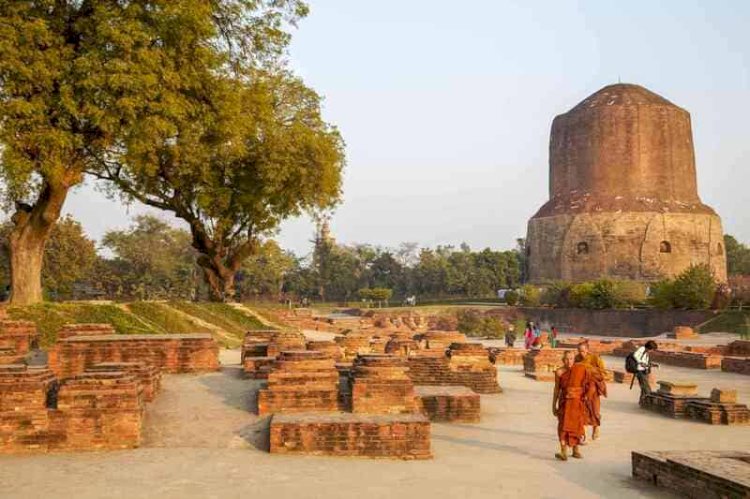Sarnath, Uttar Pradesh
Explore the historical significance of Sarnath, Uttar Pradesh through this informative blog. Learn about the religious and cultural heritage of this ancient Buddhist site, and discover the must-see attractions for your next visit.

Sarnath: A Glimpse into the Heart of Buddhist Heritage
Sarnath, an ancient Buddhist pilgrimage site, holds a special place in India’s rich spiritual history. Located in Uttar Pradesh, Sarnath is one of the four key holy Buddhist sites in India, alongside Bodh Gaya, Kushinagar, and Lumbini. Visitors from around the globe flock to Sarnath to immerse themselves in its profound historical and spiritual significance. In this blog, we explore the history, importance, and key attractions of Sarnath.
History
Sarnath is revered as the location where Lord Buddha delivered his first sermon to his five disciples after attaining enlightenment, initiating the turning of the Wheel of Dharma (Dharma Chakra Pravartan). During the Mauryan Empire, the site flourished as a center for culture and learning. Emperor Ashoka, one of Buddhism's most famous patrons, visited Sarnath in 249 BCE and constructed numerous stupas and monasteries. He also erected the famous Ashoka Pillar, inscribed with details about his conversion to Buddhism and his efforts to spread the faith.
The site continued to thrive during the Gupta period (4th–6th century CE), a time when Buddhist philosophy, art, and culture reached new heights. During this era, several monasteries and temples were constructed, establishing Sarnath as a key center for Buddhist learning.
However, the site faced devastation in the 12th century when Turkish invaders destroyed much of Sarnath, leaving it in ruins for centuries. It wasn’t until the 19th century that British archaeologists rediscovered the remains and began extensive excavations to restore the ancient site.
Significance
Sarnath’s importance to Buddhists worldwide stems from its connection to Lord Buddha’s first sermon, where he shared the fundamental teachings of Buddhism—the Four Noble Truths and the Eightfold Path. This event is considered one of the pivotal moments in the spread of Buddhism.
In addition, Sarnath is home to several historic stupas and monasteries. The Dhamek Stupa, built by Emperor Ashoka, stands as one of the largest and most well-preserved stupas globally, symbolizing the place where Buddha first taught his disciples. Standing over 43 meters tall, this stupa represents centuries of Buddhist devotion and architectural mastery.
Attractions in Sarnath

Dhamek Stupa
This towering stupa is the most iconic structure in Sarnath. With its impressive height of 43 meters, the Dhamek Stupa is adorned with intricate carvings and inscriptions that reflect the deep spiritual and historical significance of the site. Built of brick and stone, it marks the spot where Buddha gave his first sermon.
Chaukhandi Stupa
The Chaukhandi Stupa is a smaller yet equally significant structure. It commemorates the spot where Lord Buddha first met his disciples after achieving enlightenment. This stupa stands as a symbol of their union and the beginning of the Buddha's teachings.
Mulagandha Kuti Vihar
A beautifully constructed temple, Mulagandha Kuti Vihar is renowned for its serene atmosphere and artistic grandeur. Housing a statue of Lord Buddha, the temple is adorned with intricate carvings and colorful murals depicting scenes from Buddha’s life. It is a peaceful place for meditation and reflection.
Sarnath Museum

For those interested in the history and archaeology of Sarnath, the Sarnath Museum is a must-visit. It houses a rich collection of artifacts from the site, including sculptures, inscriptions, and coins from various historical periods. The museum also contains the famous Ashoka Lion Capital, which serves as the national emblem of India.
Conclusion
Sarnath remains a significant pilgrimage site for Buddhists and a captivating destination for history enthusiasts. Its ancient stupas, temples, and museums serve as enduring reminders of the area’s spiritual and cultural legacy. Visitors to Sarnath can experience not only its rich history but also its deep sense of peace and spiritual resonance, making it a truly unique and inspiring place.

 Deepak Maurya
Deepak Maurya 





























